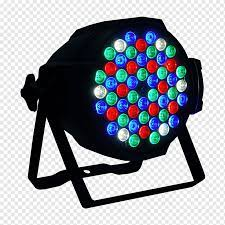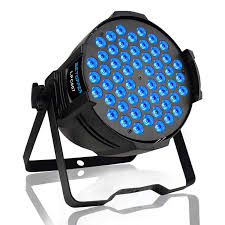
As a musician or mobile DJ, you probably know that lighting is essential to create an unforgettable mood and atmosphere. But what type of moving head led stage lights to choose for your event? PAR projectors, blinders, strobes, and moonflower and derby effects, moving heads, scanners, lasers, halogen lamps, LEDs…
The choice is so vast that finding the right model for your needs often becomes difficult. In this blog, our guest blogger Bo will guide you through this ocean of possibilities!
Foreword
- In this blog, I will focus on stage lighting suitable for small to medium-sized party, club, or concert use.
- In order to avoid frequent repetitions of the term ‘lamp’, I will also use the words ‘frame’ and ‘projector’. These two terms refer to the lamp housing, but are often used to refer to the device in general.
Types of stage moving head led stage lights
For me, stage lights can be divided into the following groups:
Static lighting (no moving parts)
- PAR headlamps
- Blinders and strobes
Light effects
- Traditional play of light
- Lyres and scanners
- Lasers
Static moving head led stage lights
Conventional PAR (halogen) floodlights
Until a few years ago, PAR projectors were widely used in nightclubs. Today these have been replaced by moving head led stage lights, but they have not totally disappeared thanks to a few obvious advantages.
Indeed, in addition to being more affordable, PAR projectors offer a continuous dimming of up to 1% of the light output, which is often difficult to achieve for LEDs. As for the drawbacks, PARs convert around 3.5% of their electrical power into light.
The rest is turned into heat, which can be problematic in spaces not suited to high temperatures, or when working with limited power. In addition, they display a relatively short lifespan compared to LEDs. APAR halogen has a lifespan of around 1000 hours, while an LED can reach 50,000 hours. Last point: colored lighting requires the use of color filters, which reduces brightness.
LED ‘PAR’ floodlights
The word ‘PAR’ is in quotes because the term LED PAR is not quite correct. The word ‘PAR’ refers to PAR Can, a term rather used to designate the frame, or the housing of the lamp. The technique and frame of an LED PAR bear very little resemblance to that of a traditional halogen PAR.
However, the term LED PAR has entered so much common vocabulary that I will continue to use it to avoid confusion. The moving head led stage lights is also the reason for the disappearance of halogen PAR projectors. Here are some important advantages of LED PARs over halogen PARs:
- They are effective. The heat loss relative to the brightness is negligible.
- They benefit from a compact design.
- They are quite robust. A halogen PAR has a large glass lamp, as well as a filament that can easily break due to shocks.
- You have a lot of colors in one device.
- They are DMX compatible, so you won’t need any external dimmers.
- They do not generate heat and can therefore be placed on the ground without having to worry about fires.
Individual LEDs vs moving head led stage lights
There are several types of LED PARs: those with individual colored LEDs (= the most economical solution) and those with multi-LED chips. It is capable of creating multiple colors.
The RGBA chips, on the other hand, can provide warm white light through the amber LED.
You can recognize an individual LED spotlight by its large number of small lamps (right). A multi-LED chip fixture only offers a small number of larger lamps (left). As you can see, the latter produces a smoother color mix.
How to mix moving head led stage lights?
When you mix a white color with RGB LEDs, you get red, green, and blue shadows. This is because the individual colors come from different places and therefore fall on the illuminated object from different angles. This can be annoying when used in theaters or for architectural lighting of a wall with an uneven surface. You will not face this problem when using multi- moving head led stage lights, since this one mixes all the colors in the same place. My conclusion, therefore, is that the individual LED fixtures are perfectly suited for small parties. Multi-LED chip projectors are ideal for rentals, weddings and concerts.

LED bars vs moving head led stage lights
The only difference between an LED PAR and an LED bar is the construction of the frame. Due to its shape, an LED bar provides a wider distribution of light, which makes it ideally suited for lighting surfaces.
I like to hang the LED bars in an upright position; the space between the different LEDs creates an effect pleasing to the eye. It allow particularly precise pixel mapping, allowing you to drive each LED chip individually. So you can, for example, adjust the color and degree of dimming for each of the LEDs. This is not possible for LED PARs, where all chips do exactly the same.
Traditional play of light
These plays of light make it possible to fill a space with moving lights. The most famous type of effect is the ‘ derby ‘. This device consists of a set of moving lights hidden behind several rows of lenses. The moving head led stage lights is one example.
A derby effect is the ideal starting point for those new to the subject. Versatile, derby can also replace mirror balls – difficult to assemble as a traveling DJ, for example – during a slow dance. You only have to select slow moving head led stage lights rotation via DMX to fill the room with small, slowly moving white squares.
Lyres
The lyre is a lamp that is used in particular at festivals and large-scale parties. It is equipped with a mobile head capable of moving in all directions and projecting gobos and colors. We separate three main families: spot, beam and wash. There are also hybrid models that combine all three of these effects, but they will not be covered in this blog due to the high price tag.



